
Seven Mile Island
also known as Nonquon Island

Aerial view of Seven Mile Island taken in 1982
One of the most magnificent properties to have ever been developed in Scugog Township is Seven Mile Island. This relatively isolated piece of land, found attached to Scugog Island by a narrow causeway, has been home to a number of wealthy residents over the past 100 years. Seven Mile Island, as it is known today, was originally several packages of land, which over the years was assembled into a 91 acre parcel.
Records dating back to the early 1880s show Albert C. Stevens as owner of the land, which at that time was referred to as Nonquon Island. Mr. Stevens operated the property as a sportsman's home, providing comfortable accommodation for hunters and fishermen, many whom travelled from parts of Canada and the U.S.A., to enjoy the tremendous fishing and shooting available on and around Lake Scugog. While Mr. Stevens and his wife provided adequate facilities for their guests, the property paled in comparison to what it would become through much of the next century.
From the mid 1890s until 1919 the property changed hands a number of times. Some of the owners during this period include: Harry Beasley (1902-09), Silas E. VanCamp (1910), George Cotton (1911) and Thomas Stinzel (1912-19).

Delmont Cottage about 1915
Thomas Stinzel lived in the original log cabin on the property before beginning construction of a large new house which he named Delmont Cottage, the same name the old log house had been called.
A news item in an October 1912 issue of the Port Perry Star reported that Seven Mile Island Hotel was a popular spot for hunters, indicating that Mr. Stinzel rented out rooms to duck hunters during the fall. Another report in 1916 suggests that the Island was a popular spot for excursions, where participants could enjoy swimming, boating and picnics in front of the hotel.
While Seven Mile Island was under the ownership of Mr. Stinzel, he also developed a registered plan of subdivision for 19 lots along the north-west shore of Lake Scugog.
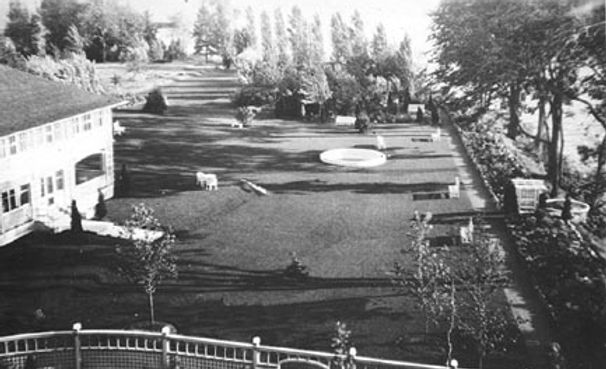
View of Wilson's beautiful property from on top of the water tower
View of Wilson's beautiful property from on top of the water tower
On May 2, 1919, Alex Ross Wilson and his wife Mary purchased Seven Mile Island from Thomas Stinzel and began to develop the property into what would become a magnificent estate. Mr. Wilson amassed his wealth as owner of his father's company, Andrew Wilson & Co., which manufactured the very popular "Bachelor" brand cigars. In 1923 the business was taken over by the Imperial Tobacco Co. Ltd., although Mr. Wilson continued as its president until 1929.
After leaving the tobacco company, Mr. Wilson became vice-president of Consolidated Press Limited of Toronto, publishers of Saturday Night, The Canadian Home Journal and the Farmer's Magazine.
Over the next few years they assembled a number of small parcels of land abutting the area, until they had accumulated approximately 91 acres. It was during the Wilson's ownership of the Seven Mile Island that this relatively undeveloped land, was turned into an estate showplace.
The Wilsons immediately started work on enlarging Delmont Cottage, adding a number of buildings to the property, constructing numerous floral gardens, a swimming pool, tea house, reflecting pool and an elaborate boathouse with a dance hall on the upper level. The property boasted beautifully manicured lawns, rose gardens, bridges, ponds and an elaborate pergola leading to the magnificent 26 room mansion.
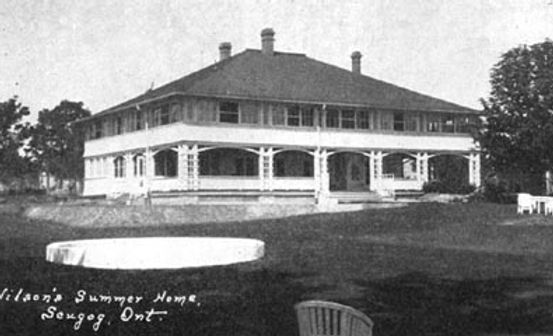
Delmont Cottage after Wilson's enlarged it in the 1920s
Mr. Wilson hired talented Scottish stonemasons to erect huge stone pillars, the shape of cigars, at the entrance to the property and also construct stone fences and walkways throughout the property. The craftsmen came to the estate to do this work after completing the construction of Casa Loma in Toronto.
While residents of Seven Mile Island, Mr. and Mrs. Wilson became quite involved within the community. They were known for their generosity, purchasing new uniforms for the Port Perry Band on one occasion, and donating $1,000 towards cleaning up Lake Scugog on another.

Flower gardens flank the entrance to an ornate pergola in the 1930s
Occasionally, the Wilsons would open their property to the community for garden parties. On one of these occasions in August 1927 Port Perry Star publisher Samuel Farmer described the event as follows:
"A Gala day on Scugog as Mr. and Mrs. A.R. Wilson opened the grounds of Seven Mile Island for a garden party which the whole community attended. "
"We can't think of it, without a feeling of shame, for the way in which the crowd acted was more like hungry refugees than guests."
Mr. Wilson was 71 years old when he died at his home at 5 Beaumont Rd., in the Rosedale district of Toronto, on October 12, 1941, after an illness of about two months. He was survived by his wife Mary, a step-daughter Mrs. Roy McConnell, and a nephew, R.A. Wilson.
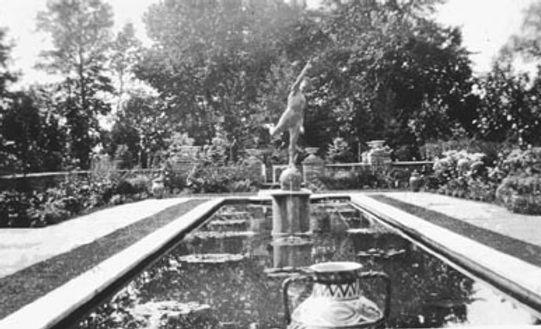
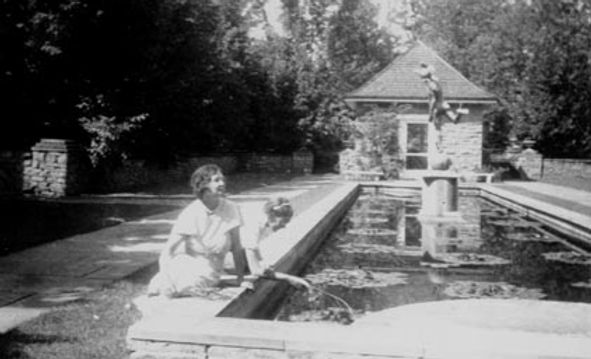
The Reflecting Pool, about 1930, with Mary Wilson along side
Following the death of her husband, Mrs. Wilson lost interest in the estate and about two years later, on September 4, 1943, she sold Seven Mile Island for a mere $18,000 to Harry S. Ely and his wife Freda. Mr. Ely was one of a group of four men who joined forces to purchase the property but before the deal closed, his three partners backed out, leaving Mr. Ely to arrange financing for the purchase on his own.
Harry Ely was the owner of "VanKirk Chocolate Corporation," a chocolate manufacturing company located at 301 King St., Toronto. The company made chocolates and chocolate bars for a variety of stores, including Loblaws, Dominion and Eatons, and also provided chocolate bars under the "VanKirk" name for movie theaters. He was probably most famous for developing a baking product under the brand name "Chipits."
Harry Ely passed away when he was only 41-year-old, but the firm contined under the management of his wife, and later with the help of Freda's second husband, Henry L. (Harry) Fogler.
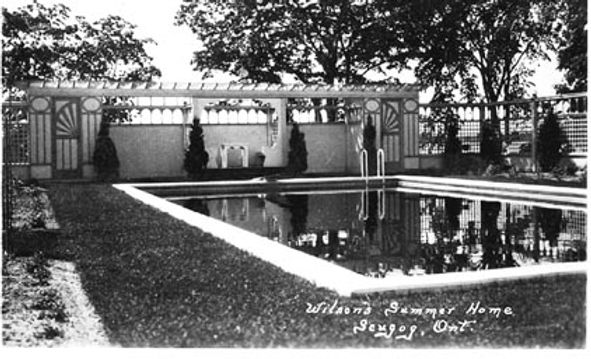
Swimming pool at the Wilson's home on Seven Mile Island
The VanKirk company was sold to an American firm, and was later purchased by the Hershey Co. "Chipits" are still produced by Hershey today, using the same logo designed by Harry Ely more than 60 years ago.
Mrs. Freda (Ely) Fogler, now more than 93 years of age, remembers when they purchased Seven Mile Island from Mary Wilson, it was in a state of disrepair and neglect. "The lawns looked like hay fields," she said, and remembered working "like fiends" to cut down the waist high grass and clean up the property.
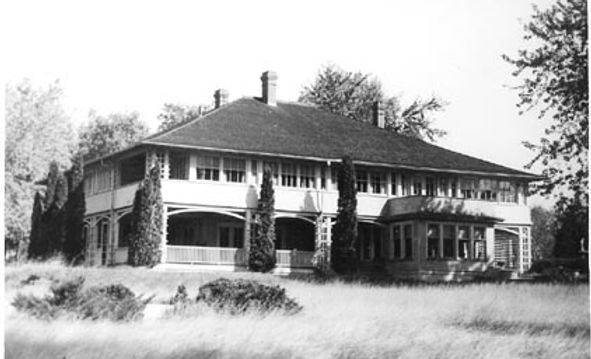
How the property looked when Harry and Freda Ely purchased it in 1948
While owner of Seven Mile Island, Harry Ely also purchased two farms adjacent to the island estate, but outside the main gates on the mainland of Scugog Island.
Mrs. Fogler recalled that the family was not initially received with open arms in the community, speculating it may have had something to do with them being Jewish. Gradually the family did become accepted, and they did much of their shopping in town for groceries and summer clothing. She particularly remembered shopping at Bentley's Jewellers, Brock's Department Store and the two local grocery stores, Dowson's Red & White and McKee's Superior store.
Freda Ely spent most summers at Seven Mile Island with her two young children, and her parents, who lived in a small cottage on the property overlooking the lake. Mr. Ely lived at their Old Forest Hill Rd. home during the week, while he was tending to business, but arrived at Seven Mile Island almost every weekend to relax and to enjoy his leisure time raising and breeding Palomino ponies.

They converted the large residence into apartments in which family and friends could stay for the summer months and enjoy horseback riding, swimming, sailing, pool-side parties and leisurely strolls around the beautiful grounds.
There were about 16 children of various family members living at Seven Mile Island throughout the summer, so a day camp was started, with a camp director and counsellors hired to run the children's programs. "Camp Ely" was operated near the reflecting pool and also in the upper storey of the boat house. The Elys provided playground equipment, swings and a sandbox, and the councillors taught the children crafts, played water games in shallow water of the reflecting pool, learned how to ride ponies and enjoyed hayrides. The children also had a roped-off area in the lake, near the boathouse, where they swam and played in the shallow water along the shoreline.

One of the ornate water fountains found in the gardens
Among the noted families who brought their children to the island camp was comedian Frank Shuster.
Rumors that the property was being used as a refugee camp, for children rescued from Europe during the war, are unfounded, but the fact there was a summer camp for children on the estate, may have led to this rumour.
Although Harry Ely died in 1950, it wasn't until June 1958, that Mrs. Ely disposed of their summer home. She said the Island was truly a wonderful place filled with many unforgettable memories, and regretted having to give it up.
Mrs. Fogler sold Seven Mile Island for about $50,000 to a company called Harrison Holdings, which was owned by Patrick Harrison and his wife Lucette.
Mr. Harrison was a mining engineer at the time, and initially he and his wife used the property as a summer retreat. Eventually, the Harrisons moved in and took up permanent residence at Seven Mile Island, spending an estimated $1 million on improvements to the property, including construction of two guest houses for his daughters.
Mr. Harrison continued to live on the property for a number of years following the death his first wife, but in 1981 at the age of 80 years, he decided to sell the estate. It took almost two years to sell the property, but ownership changed in July 1983, with a registered Ontario corporation purchasing the property for a Toronto group known as the Ching Chung Taoist Society of Canada.
The new owners began work converting the main house into a hotel, a second residence into a restaurant and divided the remaining houses into rental units. In 1984 Seven Mile Island was opened to the public and many people from the Scugog area enjoyed lunches and dinners in the restaurant as well as leisurely strolls throughout this unique property.
In 1987, the property was leased by local real estate agent Mark Smith and his partner Greg Fish. They formed a syndicate of 12 investors who intended to develop the property. This idea never came to fruition.
Next it was leased to a group who opened "Harmony Island Estate" a school for troubled boys. The school opened in October 1992 but this venture also failed. After this, the property sat virtually empty and began to deteriorate rapidly over the next few years. Unfortunately during this time, vandals struck at the estate, destroying many of the ornate statues and intricate fencework.
In June 1995 the property was transferred into the name of the International Taoist Church of Canada, and during the summer of 1998, Seven Mile Island once again was listed for sale. Unfortunately, over the past decade, the property has become run-down, fencing and buildings have started to deteriorate, or have been vandalized and this once magnificent estate is now in a sad state of disrepair.
In June 2002, a group of enthusiastic investors, many from the artistic community, purchased the property with the idea of establishing a school for the study of art. The group, Artis Orbus Inc. is headed by Charlotte Hale, owner of Veni Vidi Gallery in Port Perry. Work began immediately on stabalizing the buildings and damaged structures, as well as cleaning and clearing the property of overgrowth created by decades of neglect.
This enthusiastic group of people have an enormous job ahead of them, but in time they hope to return Seven Mile Island to its original splendor and establish a new home for the arts.

Iron gate gave privacy to the Seven Mile Island estate
A Walking Tour of Seven Mile Island Estate
Pictures for this walking tour taken in July 1982
"Cool breezes billow across Lake Scugog, rustle through tall pine trees, and move past the sanctuary, European-style gardens and the cool white house on the southern top of the property. Only the sound of the waves lapping against the shores of the island estate and the call of the wildlife breaks the silence."
This is how Seven Mile Island was described by a real estate company hired to sell the property for Patrick Harrison in 1982. Mr. Harrison invited a number of Port Perry business people and residents to his island retreat that summer for a barbeque, and to view the property.
The following story and photographs were recorded by Port Perry Star publisher, J. Peter Hvidsten that beautiful summer afternoon.

Cigar shaped pillars along the road at the entrance
To reach the 26 acre estate property, we pass through two tall, cigar-shaped pillars and proceed along a narrow 1,650 foot causeway. Over-grown brush and trees crowd the roadway and provide a beautiful canopy for the brief trip between mainland Scugog Island and this private hideaway situated in the middle of 65 acres of wildlife sanctuary.

The long, narrow causeway leading to Seven Mile Island
As we reach the other side, the narrow roadway winds past two of the five houses on the property before reaching the main residence.
The two-storey house consists of 28-rooms and covers about 2,600 sq. ft. per floor. On the main floor is a 24'x17' kitchen which leads to a large dining area.
Beyond another set of doors is a large living room, which incorporates beamed ceilings and a fireplace. In all there are four fireplaces in the main residence. The upper floor is taken up by eight bedrooms, a large sitting room and a den.
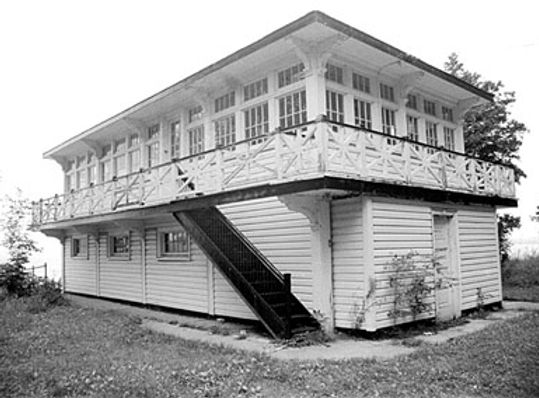
Two storey boathouse with dance floor on upper level in 1982
Leaving the house, moving west along the shoreline of Lake Scugog is an enormous rock garden with a small stream running throughout and a massive stone barbecue.
Not far away is a lookout point, seaplane dock and a beautiful 50'x24' in-ground pool, surrounded by an ornate lattice fence and globe lighting. And next to the pool is a four-bedroom house with greenhouses and a germination building.
Proceeding south, past the main residence again, we come upon one of the numerous stone-lined walkways. One of these leads to the lake and a large two-storey boathouse. The upper section of this building was used for elaborate parties and dancing during the 1920s and 1930s.
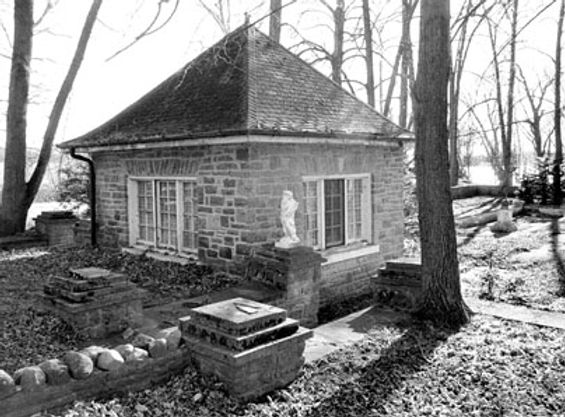
The stone teahouse overlooking the reflecting pool
Strolling from the boathouse, along another of the stone walkways, we come upon a stone teahouse nestled at the end of a 62'x14' reflecting pool. In the middle of the pool is a bronze statue of the Greek God "Mercury."
Moving along from this tranquil setting we arrive at the roadway once again, and as we travel along the circular drive we arrive at an ornate pergola flanked at the entrance by two of the dozens of statues found throughout the property.
The pergola, an ornate lattice covered walkway, leads us back towards the main residence and to a large fountain, birdhouse and beautiful gardens on the east side of the house. We also find here a large rose garden with more walkways, a stream and ponds.

One of the many stoned walkways around the island estate
This describes Seven Mile Island as it looked, some 60 years after the Wilson's created their island retreat.
The following description of the property was taken from a real estate sales pamphlet in 1988, when the property was for sale:
Seven Mile Island consists of approximately 95 acres of land which includes a 27 acre Island, 28 acres on the mainland and 40 acres of submerged land.
Twelve acres of the property is being used as a resort which consists of the Scugog House (restaurant), the Wilson House (bar, video room, office and 10 rooms), Durham House (four cabins), Lindsay House (four cabins), storage house, caretakers house, greenhouse, tea house, boat house, garage, three barns, tennis courts, inground pool, two sets of docks, six fountains and five ponds or pools.
